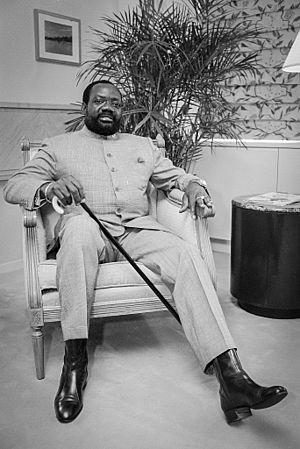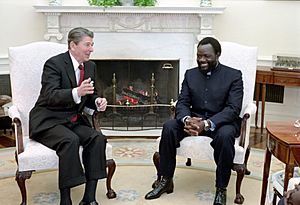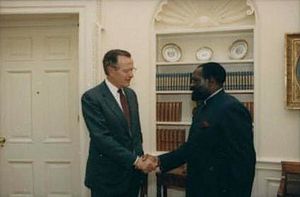Jonas Savimbi facts for kids
Quick facts for kids
Jonas Savimbi
|
|
|---|---|

Jonas Savimbi in 1990
|
|
| Birth name | Jonas Malheiro Savimbi |
| Born | 3 August 1934 Munhango, Bié Province, Portuguese Angola |
| Died | 22 February 2002 (aged 67) Lucusse, Moxico Province, Angola |
| Allegiance | |
| Years of service | 1964–2002 |
| Rank | General |
| Commands held | President and Supreme Commander of UNITA (1966–2002) |
| Battles/wars | Angolan War of Independence Angolan Civil War |
Jonas Malheiro Savimbi (born August 3, 1934 – died February 22, 2002) was an important political and military leader from Angola. He started and led a group called the National Union for the Total Independence of Angola (UNITA).
UNITA fought a guerrilla war (a type of fighting where small groups use surprise attacks) against Portuguese rule in Angola from 1966 to 1974. After Angola became independent, UNITA fought against another group called the People's Movement for the Liberation of Angola (MPLA) during the Angolan Civil War. Savimbi died in a fight with government soldiers in 2002.
Contents
Early Life and Education
Jonas Savimbi was born in Munhango, a small town in Bié Province, Angola. His father worked for the railway and was also a preacher. His parents were part of the Ovimbundu people, who later became a strong base of support for Savimbi.
Savimbi went to Protestant and Roman Catholic schools when he was young. At age 24, he got a scholarship to study in Portugal. He wanted to study medicine, but he couldn't because of the strict rules of the government at the time.
Instead, he met other students from Portuguese colonies who wanted to fight against colonial rule. He also met Agostinho Neto, who later became Angola's first president. Savimbi faced pressure from the Portuguese secret police, so he moved to Switzerland. There, he received another scholarship and studied social sciences.
In 1960, Savimbi met Holden Roberto, who was already working for Angolan independence. Roberto was a founder of the UPA (Union of the Peoples of Angola). Savimbi decided to join the fight for independence after meeting leaders like Jomo Kenyatta from Kenya.
He officially joined the UPA, which later became the FNLA (National Front for the Liberation of Angola). In 1962, when these groups formed the GRAE (Revolutionary Government of Angola in Exile), Savimbi became their Foreign Minister.
Military Career and UNITA
Savimbi wanted to be a leader in the MPLA, but they turned him down. So, in 1964, he joined forces with the FNLA. In the same year, he helped create UNITA with Antonio da Costa Fernandes. Savimbi traveled to China, where he was promised weapons and military training.
When he returned to Angola in 1966, he officially started UNITA. He began fighting against the Portuguese rulers. He also fought against the FNLA and MPLA, as all three groups wanted to lead Angola after it became independent. Later, old documents showed that Savimbi had an agreement with the Portuguese authorities to fight against the MPLA.
After Angola gained independence in 1975, Savimbi gained the attention of powerful leaders in China and the United States. He had been trained in China in the 1960s and was a very skilled guerrilla fighter. He used tactics like confusing his enemies with different attacks. Like Mao Zedong's army, Savimbi got support from many people in the countryside, especially the Ovimbundu people. Many people consider him one of the most effective guerrilla leaders of the 20th century.
The Angolan Civil War
The MPLA was supported by the Soviet Union and its allies, and they followed Marxist-Leninist ideas. Savimbi then changed his views and presented himself as someone who was against communism. This made the war between the MPLA and UNITA part of the larger Cold War between the United States and the Soviet Union. Both sides saw the conflict as important for global power.
Support from the United States
In 1985, the Reagan government in the U.S. began to support Savimbi. American conservatives helped organize a meeting in Jamba, Angola, which was UNITA's base. Savimbi was strongly supported by a group called The Heritage Foundation. Their experts visited Savimbi in his camps and gave him advice for his war against the Angolan government.
Savimbi's supporters in the U.S. convinced the Central Intelligence Agency (CIA) to send weapons and help recruit fighters for UNITA. In 1986, President Reagan invited Savimbi to the White House. After their meeting, Reagan said that UNITA would achieve "a victory that electrifies the world."
Two years later, Savimbi returned to Washington and thanked the Heritage Foundation for their help.
Military and Political Actions

Besides his military skills, Savimbi was also known for being very smart. He spoke seven languages, including Portuguese, French, and English. When he met foreign diplomats and gave speeches in America, he often talked about famous Western thinkers. He became one of the strongest voices against communism from the developing world.
People who knew Savimbi described him as an amazing linguist and a great conversationalist. However, Savimbi also accused his political opponents of using witchcraft. Some saw him as a leader fighting for freedom, while others saw him as someone who only wanted power.
As the U.S. started giving more support, Savimbi gained important advantages in the late 1980s and early 1990s. This made the Soviet Union and Cuba rethink their involvement in Angola, as their soldiers were dying and Savimbi's control on the ground grew.
By 1989, UNITA controlled some areas completely and could launch attacks almost anywhere in Angola, except for the main coastal cities. At the peak of his military success, Savimbi began attacking government and military targets near the capital city, Luanda. It seemed like Savimbi was getting ready for a possible military victory.
The Soviet leader Mikhail Gorbachev even discussed the Angolan war with Reagan during their meetings. Savimbi also met with Reagan's successor, George H. W. Bush, who promised UNITA "all appropriate and effective assistance."
The 1990s
In early 1990, Savimbi was injured in fights with Angolan government troops. But his injuries didn't stop him from returning to Washington to meet with his American supporters and President Bush. They wanted to get even more military help for UNITA.
In February 1992, two UNITA leaders, Antonio da Costa Fernandes and Nzau Puna, left the group. They said publicly that Savimbi was not interested in peace but wanted to prepare for another war. Despite this, the Angolan government negotiated a cease-fire with Savimbi. Savimbi then ran for president in the 1992 national elections.
International observers said the election was fair. Savimbi received about 40% of the votes, and the current president, José Eduardo dos Santos, received 49%. Since neither got the 50% needed to win, a second election was planned.
In October 1992, Savimbi sent two senior UNITA leaders, Jeremias Chitunda and Elias Salupeto Pena, to Luanda to discuss the second election. On November 2, 1992, their group was attacked by government forces in Luanda. Chitunda and Pena were killed, and their bodies were never returned. This event led to a period known as the Halloween Massacre, where many UNITA supporters were killed. Savimbi claimed the election was unfair and that the government wasn't committed to peace. He pulled out of the election and started fighting again. UNITA quickly gained ground militarily and surrounded the capital, Luanda.
In 1994, UNITA signed a new peace agreement. Savimbi was offered the position of vice-president, but he turned it down and started fighting again in 1998.
Death
Jonas Savimbi had survived many attempts on his life and had been reported dead at least 17 times. But on February 22, 2002, he was killed in a battle with Angolan government soldiers. The fight happened along a river in Moxico Province, his home province. Savimbi was shot many times and died almost immediately.
Because Savimbi had a reputation for always escaping the Angolan military, many Angolans didn't believe he was dead at first. But then pictures of his body appeared on Angolan television, and the U.S. State Department confirmed his death. He was buried in Luena Main Cemetery. In 2008, his tomb was damaged, and some people were arrested. His body was later dug up and reburied publicly in 2019.
Legacy
After Savimbi's death, António Dembo took over as UNITA's interim leader. However, Dembo had been wounded in the same attack that killed Savimbi, and he died ten days later. Paulo Lukamba then became the leader. Six weeks after Savimbi's death, UNITA and the MPLA signed a cease-fire agreement.
Even today, Savimbi's legacy is debated. Some believe his biggest mistake was rejecting the 1992 election results and going back to war. Others remember him as a very charismatic leader who inspired many people. He had several wives and at least 25 children.
See also
 In Spanish: Jonas Savimbi para niños
In Spanish: Jonas Savimbi para niños
- Kimberley Process Certification Scheme



